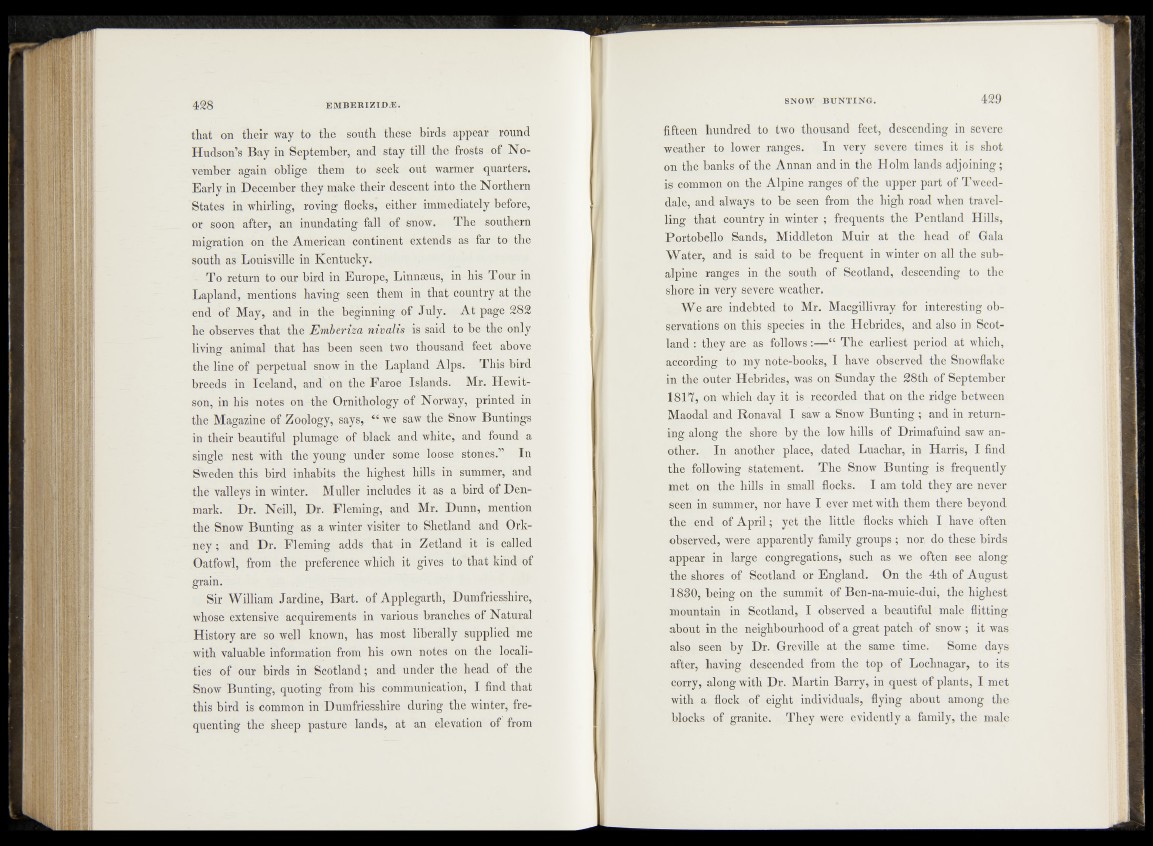
that on their way to the south these birds appear round
Hudson’s Bay in September, and stay till the frosts of November
again oblige them to seek out warmer quarters.
Early in December they make their descent into the Northern
States in whirling, roving flocks, either immediately before,
or soon after, an inundating fall of snow. The southern
migration on the American continent extends as far to the
south as Louisville in Kentucky.
To return to our bird in Europe, Linnaeus, in his Tour in
Lapland, mentions having seen them in that country at the
end of May, and in the beginning of July. At page 282
he observes that the Emberiza nivalis is said to be the only
living animal that has been seen two thousand feet above
the line of perpetual snow in the Lapland Alps. This bird
breeds in Iceland, and on the Faroe Islands. Mr. Hewit-
son, in his notes on the Ornithology of Norway, printed in
the Magazine of Zoology, says, “ we saw the Snow Buntings
in their beautiful plumage of black and white, and found a
single nest with the young under some loose stones.” In
Sweden this bird inhabits the highest hills in summer, and
the valleys in winter. Muller includes it as a bird of Denmark.
Dr. Neill, Dr. Fleming, and Mr. Dunn, mention
the Snow Bunting as a winter visiter to Shetland and Orkney
; and Dr. Fleming adds that in Zetland it is called
Oatfowl, from the preference which it gives to that kind of
grain.
Sir William Jardine, Bart, of Applegarth, Dumfriesshire,
whose extensive acquirements in various branches of Natural
History are so well known, has most liberally supplied me
with valuable information from his own notes on the localities
of our birds in Scotland; and under the head of the
Snow Bunting, quoting from his communication, I find that
this bird is common in Dumfriesshire during the winter, frequenting
the sheep pasture lands, at an elevation of from
fifteen hundred to two thousand feet, descending in severe
weather to lower ranges. In very severe times it is shot
on the banks of the Annan and in the Holm lands adjoining;
is common on the Alpine ranges of the upper part of Tweed-
dale, and always to be seen from the high road when travelling
that country in winter ; frequents the Pentland Hills,
Portobello Sands, Middleton Muir at the head of Gala
Water, and is said to be frequent in winter on all the sub-
alpine ranges in the south of Scotland, descending to the
shore in very severe weather.
We are indebted to Mr. Macgillivray for interesting observations
on this species in the Hebrides, and also in Scotland
: they are as follows:—“ The earliest period at which,
according to my note-books, I have observed the Snowflake
in the outer Hebrides, was on Sunday the 28th of September
1817, on which day it is recorded that on the ridge between
Maodal and Ronaval I saw a Snow Bunting ; and in returning
along the shore by the low hills of Drimafuind saw another.
In another place, dated Luachar, in Harris, I find
the following statement. The Snow Bunting is frequently
met on the hills in small flocks. I am told they are never
seen in summer, nor have I ever met with them there beyond
the end of April; yet the little flocks which I have often
observed, were apparently family groups ; nor. do these birds
appear in large congregations, such as we often see along
the shores of Scotland or England. On the 4th of August
1880, being on the summit of Ben-na-muic-dui, the highest
mountain in Scotland, I observed a beautiful male flitting
about in the neighbourhood of a great patch of snow ; it was
also seen by Dr. Greville at the same time. Some days
after, having descended from the top of Lochnagar, to its
corry, along with Dr. Martin Barry, in quest of plants, I met
with a flock of eight individuals, flying about among the
blocks of granite. They were evidently a family, the male